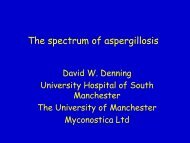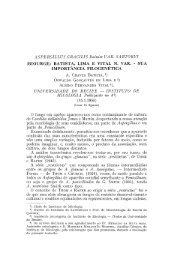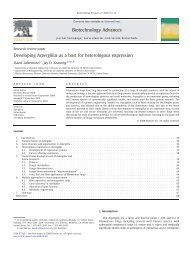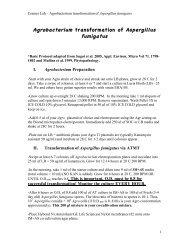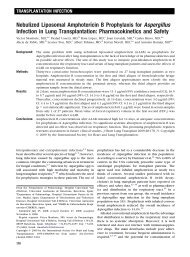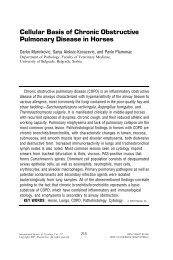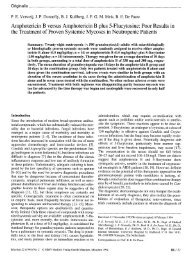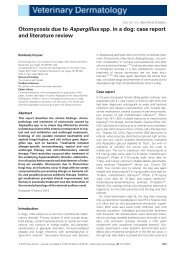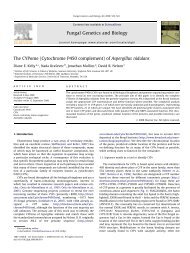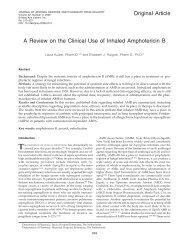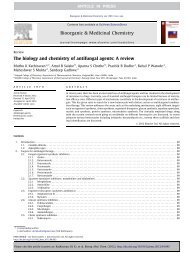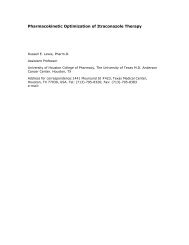A novel selectable marker based on Aspergillus niger arginase ...
A novel selectable marker based on Aspergillus niger arginase ...
A novel selectable marker based on Aspergillus niger arginase ...
Create successful ePaper yourself
Turn your PDF publications into a flip-book with our unique Google optimized e-Paper software.
Enzyme and Microbial Technology 51 (2012) 53– 58<br />
C<strong>on</strong>tents lists available at SciVerse ScienceDirect<br />
Enzyme and Microbial Technology<br />
jou rn al h om epage: www.elsevier.com/locate/emt<br />
A <str<strong>on</strong>g>novel</str<strong>on</strong>g> <str<strong>on</strong>g>selectable</str<strong>on</strong>g> <str<strong>on</strong>g>marker</str<strong>on</strong>g> <str<strong>on</strong>g>based</str<strong>on</strong>g> <strong>on</strong> <strong>Aspergillus</strong> <strong>niger</strong> <strong>arginase</strong> expressi<strong>on</strong><br />
Kashyap Dave, Manmeet Ahuja, T.N. Jayashri, Rekha Bisht Sirola, Narayan S. Punekar ∗<br />
Biotechnology Group, Department of Bioscience and Bioengineering, Indian Institute of Technology Bombay, Powai, Mumbai 400 076, India<br />
a r t i c l e i n f o<br />
Article history:<br />
Received 20 December 2011<br />
Received in revised form 5 April 2012<br />
Accepted 5 April 2012<br />
Keywords:<br />
Fungal transformati<strong>on</strong><br />
Arginase (agaA) disrupti<strong>on</strong><br />
Nutriti<strong>on</strong>al <str<strong>on</strong>g>marker</str<strong>on</strong>g>s<br />
<strong>Aspergillus</strong> <strong>niger</strong><br />
1. Introducti<strong>on</strong><br />
a b s t r a c t<br />
<strong>Aspergillus</strong> <strong>niger</strong> is an industrially useful fungus capable of<br />
secreting a range of enzymes of commercial value. There is an<br />
increasing interest in Aspergilli as expressi<strong>on</strong> systems for heterologous<br />
proteins and protoplast mediated transformati<strong>on</strong> is<br />
comm<strong>on</strong>ly employed to transform Aspergilli [1,2]. Both dominant<br />
and nutriti<strong>on</strong>al <str<strong>on</strong>g>marker</str<strong>on</strong>g>s are used to select transformants. Cost effective<br />
nutriti<strong>on</strong>al <str<strong>on</strong>g>marker</str<strong>on</strong>g>s are preferable but often mandate a suitable<br />
recipient background. This in turn requires that a critical anabolic<br />
gene (for instance, argB and pyrG) be mutated or disrupted. The<br />
<strong>Aspergillus</strong> nidulans argB gene (encoding ornithine transcarbamylase)<br />
can complement the corresp<strong>on</strong>ding auxotrophic mutati<strong>on</strong> in<br />
A. <strong>niger</strong>. Homologous complementati<strong>on</strong> by an auxotrophic <str<strong>on</strong>g>marker</str<strong>on</strong>g><br />
is preferred in filamentous fungi. Accordingly, an argB disrupti<strong>on</strong><br />
was created and complemented with its own argB gene in A. <strong>niger</strong><br />
[3]. Available selecti<strong>on</strong> <str<strong>on</strong>g>marker</str<strong>on</strong>g>s are not always suitable and an<br />
additi<strong>on</strong> to the repertoire of <str<strong>on</strong>g>marker</str<strong>on</strong>g>s is desirable. While the argB<br />
mediated selecti<strong>on</strong> exploits a critical anabolic step in arginine<br />
biosynthesis (Fig. 1), a few selecti<strong>on</strong> <str<strong>on</strong>g>marker</str<strong>on</strong>g>s involving catabolic<br />
genes (prn and pkiA) are also known [4].<br />
Arginase (the agaA gene product) provides the predominant<br />
catabolic route for l-arginine utilizati<strong>on</strong> in most fungi [5,6] and is<br />
a good candidate to establish as a nutriti<strong>on</strong>al <str<strong>on</strong>g>marker</str<strong>on</strong>g>. The recipient<br />
strain should be an agaA mutant for such a selecti<strong>on</strong> to work.<br />
The agaA mutants are difficult to score directly <strong>on</strong> media with<br />
or without l-arginine and require laborious replica plating. The<br />
metabolism of arginine, ornithine and proline in fungi are closely<br />
∗ Corresp<strong>on</strong>ding author. Tel.: +91 022 2576 7775; fax: +91 022 2572 3480.<br />
E-mail address: nsp@iitb.ac.in (N.S. Punekar).<br />
0141-0229/$ – see fr<strong>on</strong>t matter ©<br />
2012 Elsevier Inc. All rights reserved.<br />
http://dx.doi.org/10.1016/j.enzmictec.2012.04.001<br />
Selectable <str<strong>on</strong>g>marker</str<strong>on</strong>g>s are valuable tools in transforming asexual fungi like <strong>Aspergillus</strong> <strong>niger</strong>. An <strong>arginase</strong><br />
(agaA) expressi<strong>on</strong> vector and a suitable <strong>arginase</strong>-disrupted host would define a <str<strong>on</strong>g>novel</str<strong>on</strong>g> nutriti<strong>on</strong>al<br />
<str<strong>on</strong>g>marker</str<strong>on</strong>g>/selecti<strong>on</strong> for transformati<strong>on</strong>. The development of such a <str<strong>on</strong>g>marker</str<strong>on</strong>g> was successfully achieved in<br />
two steps. The single genomic copy of A. <strong>niger</strong> <strong>arginase</strong> gene was disrupted by homologous integrati<strong>on</strong><br />
of the bar <str<strong>on</strong>g>marker</str<strong>on</strong>g>. The agaA disruptant was subsequently complemented by transforming it with agaA<br />
expressi<strong>on</strong> vectors. Both citA and trpC promoters were able to drive the expressi<strong>on</strong> of <strong>arginase</strong> cDNA.<br />
Such agaA + transformants displayed <strong>arginase</strong> expressi<strong>on</strong> pattern distinct from that of the parent strain.<br />
The results are also c<strong>on</strong>sistent with a single catabolic route for arginine in this fungus. A simple yet <str<strong>on</strong>g>novel</str<strong>on</strong>g><br />
arginine-<str<strong>on</strong>g>based</str<strong>on</strong>g> selecti<strong>on</strong> for filamentous fungal transformati<strong>on</strong> is thus described.<br />
© 2012 Elsevier Inc. All rights reserved.<br />
linked [6]. The biosynthesis of arginine and ornithine proceed by<br />
the acetylated pathway whereas proline can be synthesized by<br />
two routes (Fig. 1). Proline is formed from glutamate and mutati<strong>on</strong>s<br />
in this pathway result in proline auxotrophy. Such mutants<br />
are able to use arginine as a source of proline. This metabolic feature<br />
was exploited to select agaA mutants in two filamentous fungi<br />
[5,7]. Targeted <strong>arginase</strong> gene disrupti<strong>on</strong> offers a better alternative<br />
and was achieved in two strains of Saccharomyces cerevisiae [8,9].<br />
The present work illustrates the c<strong>on</strong>structi<strong>on</strong> of an agaA disrupted<br />
strain of A. <strong>niger</strong>. We also show that the <strong>arginase</strong> negative strain<br />
can be complemented with two different agaA expressi<strong>on</strong> vectors.<br />
A <str<strong>on</strong>g>novel</str<strong>on</strong>g> tool with <strong>arginase</strong> as a fungal transformati<strong>on</strong> <str<strong>on</strong>g>marker</str<strong>on</strong>g> was<br />
thus defined.<br />
2. Materials and methods<br />
2.1. Strains and media<br />
A. <strong>niger</strong> strain NCIM 565 (Nati<strong>on</strong>al Collecti<strong>on</strong> of Industrial Microorganisms, NCL-<br />
Pune, India) was used in this study. The BAR5 strain is a bar + transformant derived<br />
from A. <strong>niger</strong> NCIM 565 described previously [10]. Various fungal stock cultures and<br />
strains were maintained as slants <strong>on</strong> potato dextrose agar or YDA (yeast nitrogen<br />
base without amino acids and amm<strong>on</strong>ium sulfate, dextrose and amm<strong>on</strong>ium nitrate)<br />
agar supplemented with phosphinothricin (PPT; 1.0 mg/ml) (for bar transformants)<br />
or minimal medium (NM) agar supplemented with 2 mM arginine (for agaA transformants).<br />
PPT is a glutamine synthetase inhibitor and bar transformants are resistant<br />
to it. pCB1265 is a plasmid carrying PtrpC-bar [11]. Growth of A. <strong>niger</strong> and selecti<strong>on</strong><br />
of bar transformants was d<strong>on</strong>e as described previously [10]. When required, NM<br />
was modified by replacing amm<strong>on</strong>ium nitrate with appropriate nitrogen source.<br />
2.2. C<strong>on</strong>structi<strong>on</strong>s to disrupt and express <strong>arginase</strong><br />
Cl<strong>on</strong>ing and propagati<strong>on</strong> of plasmids were d<strong>on</strong>e in Escherichia coli XL1-Blue<br />
(Stratagene, CA, USA) and DH5� (Life Technologies, New Delhi, India) strains according<br />
to standard protocols [12]. The E. coli strain XL1 Blue was used in all the<br />
transformati<strong>on</strong> experiments. Competent E. coli cells were prepared by PEG method
54 K. Dave et al. / Enzyme and Microbial Technology 51 (2012) 53– 58<br />
argB<br />
Glutamate Ornithine<br />
Glutamate-γ-semialdehyde<br />
Proline<br />
agaA<br />
Arginine<br />
Fig. 1. Closely c<strong>on</strong>nected metabolism of arginine, ornithine and proline in filamentous<br />
fungi. Proline is an obligate intermediate in l-arginine catabolism and therefore<br />
arginine can serve as a source of proline in proline biosynthesis mutants. Bold arrows<br />
trace the two routes of proline synthesis. The schematic also depicts the steps of<br />
arginine biosynthesis (thin arrows).<br />
Table 1<br />
List of primers used in this work.<br />
Primers Sequence (5 ′ –3 ′ ) Sequence amplified<br />
ArgMAF1 ctacatcggtgccgatctcgtggc agaA gene<br />
ArgMAR1 acaaccccatacagctggagcgat agaA gene<br />
BarPsF1 aactgcagatgagcccagaacgacgc bar probe<br />
BarXbR1 gctctagaaatctaaatctcggtgacgg bar probe<br />
CitNdR3 ggtggaagccatatggaatgtgaac PcitA<br />
DHCitF3 cataagcttggaacaccgtgcggc PcitA-aga c<strong>on</strong>structi<strong>on</strong><br />
FSDM gcgaattccatatgacttctccttcgacaat aga and agac probes<br />
JPPstI gccaagcgcgtcaagaacgc agac probe and PcitA-aga<br />
c<strong>on</strong>structi<strong>on</strong><br />
JPXhoIR gctcgagcagaccggcttgaaacg aga probe<br />
TrpARF1 ccccacttgtaagcagtagcg PtrpC-aga probe<br />
TrpARR1 atggtaccgatagcgatggagt PtrpC-aga probe<br />
TrpCENR1 cggaattcatatgtacttcctaatcgaag PtrpC<br />
T3 aattaaccctcactaaaggg PcitA probe, PtrpC-bar<br />
c<strong>on</strong>structi<strong>on</strong>, PcitA and PtrpC<br />
and stored in glycerol/PEG at −80 ◦ C until further use. All the primers used for PCR<br />
in this study are listed in Table 1. These primers were from either Sigma–Aldrich<br />
(St. Louis, USA) or from Oper<strong>on</strong> Biotechnologies Gmbh (Hilden, Germany).<br />
The agaA gene was PCR-amplified from A. <strong>niger</strong> NCIM 565 genomic DNA using<br />
primers ArgMAF1 and ArgMAR1 (Table 1). The amplic<strong>on</strong> was cl<strong>on</strong>ed into a TA cl<strong>on</strong>ing<br />
vector (pTZ57R) to obtain pTZ57R-AF. The PtrpC-bar DNA for bar expressi<strong>on</strong> was PCR<br />
amplified from pCB1265 (using primers BarXbR1 and T3), processed and inserted<br />
within the agaA ORF in pTZ57R-AF (between EcoRV and XhoI) to obtain <strong>arginase</strong><br />
disrupti<strong>on</strong> cassette pTZ57R-AF-Bar (Fig. 2A). While the agaA flanks (about 1.1 kb<br />
<strong>on</strong> both sides) in pTZ57R-AF-Bar were to facilitate homologous recombinati<strong>on</strong>, the<br />
selecti<strong>on</strong> of transformants is through bar selecti<strong>on</strong>. A functi<strong>on</strong>al bar gene c<strong>on</strong>fers<br />
PPT-resistance by acetylating and inactivating the herbicide.<br />
A functi<strong>on</strong>al citA promoter (0.5 kb P�XcitA DNA; [13]), named henceforth as<br />
PcitA, was PCR amplified (using primers T3 and CitNdR3, Table 1) and cl<strong>on</strong>ed in<br />
frame with agaA CDS [14] to obtain p�XCA (Fig. 2B). Similar PCR strategy (with<br />
primers T3 and TrpCENR1) was used to cl<strong>on</strong>e PtrpC in frame with agaA CDS to obtain<br />
pBSPtrpCaga (Fig. 2C).<br />
In all PCR reacti<strong>on</strong>s – 3.5 mM MgCl2, 250 �M dNTP’s, 0.5 �M primers and 5 units<br />
of Taq polymerase (New England BioLabs, Ipswich, USA) or Pfu Polymerase (MBI<br />
Fermentas, St. Le<strong>on</strong>-Rot, Germany) were present in 100 �l of the final PCR mixture.<br />
Genomic PCR being very sensitive to template DNA c<strong>on</strong>centrati<strong>on</strong>s, 200 ng of A. <strong>niger</strong><br />
genomic DNA was used for agaA amplificati<strong>on</strong>s. The plasmid DNA c<strong>on</strong>centrati<strong>on</strong> of<br />
20–30 ng was used for PCR amplificati<strong>on</strong> (30 cycles). Restricti<strong>on</strong> enzymes used during<br />
the c<strong>on</strong>structi<strong>on</strong> of various expressi<strong>on</strong> vectors were from New England BioLabs<br />
or MBI Fermentas. DNA fragments were extracted from agarose gel pieces using<br />
QIAquick columns (from QIAGEN Gmbh, Hilden, Germany) and Nucleospin extract<br />
II columns (from Macherey-Nagel, Düren, Germany) according to procedure recommended<br />
by the supplier. T4 DNA ligase was from MBI Fermentas. Ligati<strong>on</strong> mixtures<br />
c<strong>on</strong>tained 500 ng DNA in 50 �l reacti<strong>on</strong> volume and were performed at 22 ◦ C for 4 h.<br />
2.3. <strong>Aspergillus</strong> transformati<strong>on</strong> and agaA selecti<strong>on</strong><br />
A. <strong>niger</strong> mycelia grown in liquid NM (10 8 spores per 100 ml medium in shake<br />
flasks for 16 h, at 30 ◦ C) were harvested <strong>on</strong> cheese cloth (3–4 h after mycelial branching<br />
begins). Protoplast preparati<strong>on</strong>, transformati<strong>on</strong>, selecti<strong>on</strong> of transformants and<br />
their mitotic stability check were performed as before [10].<br />
The selecti<strong>on</strong> of agaA knockouts was d<strong>on</strong>e in two stages. First the bar transformants<br />
were selected <strong>on</strong> PPT plates. All these were subsequently replica plated <strong>on</strong><br />
media with l-arginine and l-ornithine (as sole nitrogen sources). The bar transformants<br />
that grew <strong>on</strong> l-ornithine plates but not <strong>on</strong> arginine plates were selected for<br />
further analysis. Mitotically stable, putative agaA disruptants (agaA::bar) were characterized<br />
by growth <strong>on</strong> NM agar c<strong>on</strong>taining l-arginine (5 mM), l-ornithine (10 mM)<br />
or urea (10 mM). One such agaA disrupted strain (strain D-42) served as a recipient<br />
and was complemented with agaA expressi<strong>on</strong> vector (see below).<br />
The agaA + transformants (obtained from D-42 strain), were selected directly <strong>on</strong><br />
NM agar supplemented with sucrose (1.2 M). More importantly, arginine (2 mM)<br />
replaced amm<strong>on</strong>ium nitrate as the sole nitrogen source in these plates. The agaA +<br />
transformants were propagated and maintained <strong>on</strong> NM with arginine as the sole<br />
nitrogen source (NM + Arg medium). Homologous integrati<strong>on</strong> at the agaA locus was<br />
inferred from inability to grow <strong>on</strong> PPT plates (bar − phenotype).<br />
The Southern analysis was performed as menti<strong>on</strong>ed previously [10]. Suitable bar<br />
(571 bp fragment amplified from pCB1265 with primers BarPsF1 and BarXbR1), aga<br />
(253 bp <strong>arginase</strong> ORF fragment amplified from pTZ57R-AF with primers FSDM and<br />
JPXhoIR), PcitA (508 bp NdeI-XhoI fragment isolated from the T3-CitNdR3 amplic<strong>on</strong><br />
of p�XCA), PtrpC-aga (598 bp, amplified from pBSPtrpCaga with primers TrpARF1<br />
and TrpARR1) and agac (523 bp, <strong>arginase</strong> cDNA amplified from pBSPtrpCaga with<br />
primers FSDM and JPPstI) amplic<strong>on</strong>s were digoxigenin-labeled according to manufacturer’s<br />
(Roche Applied Science) instructi<strong>on</strong>s and used as probes (at 10 ng/ml).<br />
2.4. Arginase assay<br />
A. <strong>niger</strong> mycelia were extracted with <strong>arginase</strong> extracti<strong>on</strong> buffer (200 mM imidazole<br />
HCl, 2 mM 2-mercaptoethanol, 1 mM PMSF, 12 mM MnSO4, pH 7.5) [15].<br />
Arginase was assayed by estimating the urea formed [14]. One unit of <strong>arginase</strong><br />
activity is defined as 1 �mol of urea formed in 1 min in the standard assay. Specific<br />
activity is defined as units per mg of protein. Protein was estimated according<br />
to Bradford [16].<br />
The native polyacrylamide gel electrophoresis (PAGE [17]) was performed with<br />
10% resolving gel and a 5% stacking gel; proteins were stained with Coomassie Blue<br />
R-250. Stained PAGE gels were analyzed with Geliance 1000 2D Imaging system<br />
(Perkin Elmer, CA, USA) with GeneSnap software versi<strong>on</strong> 7.04. The A. <strong>niger</strong> <strong>arginase</strong><br />
protein, heterologously expressed in and purified from E. coli [14], served as a positive<br />
c<strong>on</strong>trol.<br />
3. Results and discussi<strong>on</strong><br />
3.1. Disrupti<strong>on</strong> of A. <strong>niger</strong> <strong>arginase</strong><br />
The <strong>arginase</strong> gene from A. <strong>niger</strong> NCIM 565 (GeneBank Acc.<br />
No. AF242315) was sequenced and characterized [14]. While<br />
mutati<strong>on</strong>s and/or disrupti<strong>on</strong> of the <strong>arginase</strong> gene are valuable<br />
in understanding fungal physiology, these are not available<br />
for A. <strong>niger</strong>. Classical mutagenesis and screening by replica<br />
plating was employed to obtain <strong>arginase</strong> mutants of A. nidulans<br />
and Neurospora crassa [5,7,18]. Targeted gene disrupti<strong>on</strong><br />
through homologous recombinati<strong>on</strong> provides an alternative way<br />
to obtain near isogenic knockout strains. Am<strong>on</strong>g fungi, targeted<br />
<strong>arginase</strong> gene disrupti<strong>on</strong> is reported for yeast [8,9]. Low frequency<br />
of homologous recombinati<strong>on</strong> and the need for l<strong>on</strong>g<br />
flanking regi<strong>on</strong>s of homology limit efficient gene targeting in filamentous<br />
fungi [1,19]. Our initial attempts at disrupti<strong>on</strong> using<br />
a short <strong>arginase</strong> cDNA fragment (a 0.7 kb EcoRI–SalI fragment<br />
inserted in the multiple cl<strong>on</strong>ing site of pCB1265) were unsuccessful<br />
(n<strong>on</strong>e out of 200 bar transformants isolated). Availability of<br />
the complete sequence of the A. <strong>niger</strong> genome (http://genome.jgipsf.org/Aspni1/Aspni1.home.html)<br />
facilitated the PCR cl<strong>on</strong>ing<br />
of agaA gene with its flanking sequences (3.4 kb DNA in<br />
pTZ57R-AF). The 1.1 kb 5 ′ upstream agaA gene sequence<br />
from A. <strong>niger</strong> NCIM 565 c<strong>on</strong>tained the highly c<strong>on</strong>served<br />
ARCA binding sequence (ctctcctgggcctgtacttaggggaacaaccgttccctaaaagcaggtcttagcgat),<br />
as reported for the agaA and otaA<br />
(l-ornithine �-transaminase) promoter regi<strong>on</strong>s of A. nidulans<br />
[20,21].<br />
A disrupti<strong>on</strong> vector (pTZ57R-AF-Bar) for homologous recombinati<strong>on</strong><br />
at the agaA locus was developed from pTZ57R-AF (Fig. 2 and<br />
Secti<strong>on</strong> 2). A. <strong>niger</strong> NCIM 565 was transformed with SmaI-linearized<br />
pTZ57R-AF-Bar. Out of 234 bar transformants screened, three (designated<br />
as D-42, D-52 and E-95) did not grow <strong>on</strong> NM + Arg plates.<br />
However, they showed normal growth <strong>on</strong> l-ornithine and urea.<br />
These three potential <strong>arginase</strong> disruptants were further characterized.<br />
Apart from its poor growth <strong>on</strong> NM, strain E-95 also showed
K. Dave et al. / Enzyme and Microbial Technology 51 (2012) 53– 58 55<br />
Fig. 2. Arginase disrupti<strong>on</strong> and expressi<strong>on</strong> vectors. The bar <str<strong>on</strong>g>marker</str<strong>on</strong>g> was inserted within <strong>arginase</strong> gene (A) for disrupti<strong>on</strong>. The two promoters namely PcitA (B) and PtrpC (C),<br />
were used to drive <strong>arginase</strong> expressi<strong>on</strong>.<br />
Fig. 3. Growth of A. <strong>niger</strong> strains <strong>on</strong> different nitrogen sources. Spores of putative <strong>arginase</strong> knockout (strain D-42), parent (strain NCIM 565) and an agaA transformant (strain<br />
�XCA-29) were spot inoculated <strong>on</strong> NM medium (A), or NM without amm<strong>on</strong>ium nitrate but supplemented with 5 mM l-arginine (B), 10 mM l-ornithine (C) or 10 mM urea<br />
(D) as sole nitrogen source. Growth was recorded after 60 h.<br />
scant c<strong>on</strong>idiati<strong>on</strong> and poor hyphal development. It grew normally<br />
<strong>on</strong> l-ornithine-supplemented media suggesting a possible anomaly<br />
in l-ornithine metabolism. Further characterizati<strong>on</strong> of E-95 is in<br />
order. Comparative growth of D-42 strain and A. <strong>niger</strong> NCIM 565<br />
(parent strain) <strong>on</strong> different nitrogen sources is shown in Fig. 3. An<br />
agaA disrupted strain is not expected to grow <strong>on</strong> NM with arginine<br />
as sole nitrogen source but should grow normally <strong>on</strong> NM or<br />
NM modified with ornithine or urea (the two products of <strong>arginase</strong><br />
reacti<strong>on</strong>). The growth pattern <strong>on</strong> different nitrogen sources was<br />
c<strong>on</strong>sistent with agaA disrupti<strong>on</strong> in D-42 strain.<br />
Arginase enzyme activity in the three transformants D-42, D-52<br />
and E-95 was evaluated. Comparable growth of the three strains<br />
was ensured <strong>on</strong> NM with l-proline (50 mM) as the sole nitrogen<br />
source (also, l-proline is a n<strong>on</strong>-repressible nitrogen source). No<br />
<strong>arginase</strong> activity was detected in the mycelial extracts of these<br />
three transformants, when grown <strong>on</strong> media c<strong>on</strong>taining proline<br />
or proline + arginine. This result was independent of whether the<br />
medium c<strong>on</strong>tained 15 mM l-arginine or not, suggesting that they<br />
may not be regulatory mutants. As expected, both A. <strong>niger</strong> NCIM 565<br />
(parent strain) and BAR5 (the bar + c<strong>on</strong>trol strain) showed normal<br />
and induced (fivefold) <strong>arginase</strong> activity. The <strong>arginase</strong> activity data<br />
for the BAR5 strain (A. <strong>niger</strong> NCIM 565 with a single copy pCB1256<br />
integrati<strong>on</strong> [10]) suggested that expressi<strong>on</strong> of <strong>arginase</strong> was independent<br />
of the presence or absence of bar cassette in the genome.<br />
The absence of <strong>arginase</strong> activity in D-42 crude extracts was also corroborated<br />
by the native PAGE data; the protein band corresp<strong>on</strong>ding<br />
to <strong>arginase</strong> was absent (see below).<br />
Integrati<strong>on</strong> events in the three agaA disruptants were analyzed<br />
through Southern analysis. Restricti<strong>on</strong> enzyme digests (BamHI and<br />
HindIII) of genomic DNA from strains D-42, D-52 and E-95 were<br />
probed with two different probes (aga and bar; Secti<strong>on</strong> 2). As<br />
expected, the aga probe picked up a single DNA fragment (HindIII<br />
digesti<strong>on</strong>) from the three agaA disruptants as well as from the<br />
parent strain. The BamHI digest of the parent strain showed two<br />
bands (1.1 kb and 1.8 kb; for a schematic see Fig. S1). However, in<br />
the three agaA disruptants the larger band was of 2.6 kb (Fig. 4). The<br />
Southern data is c<strong>on</strong>sistent with the presence of an additi<strong>on</strong>al bar<br />
cassette in these strains. The 2.6 kb fragment also hybridized with<br />
the bar probe (not shown).<br />
A combinati<strong>on</strong> of growth studies, <strong>arginase</strong> protein and activity<br />
and Southern analyses point to successful disrupti<strong>on</strong> of the<br />
<strong>arginase</strong> gene in A. <strong>niger</strong> by homologous recombinati<strong>on</strong>. Despite<br />
large homologous flanking sequences employed, the frequency of A.<br />
<strong>niger</strong> agaA disruptants obtained was very low (three out of 234 bar<br />
transformants). Targeted disrupti<strong>on</strong> was shown to be best achieved<br />
by employing a �kusA strain (defective in N<strong>on</strong>-Homologous End<br />
Joining pathway for DNA repair) in which homologous recombinati<strong>on</strong><br />
predominates [22]. A. <strong>niger</strong> NCIM 565 employed in this study<br />
does not have this �kusA genetic background.<br />
While E-95 grew and sporulated poorly <strong>on</strong> NM, the integrati<strong>on</strong><br />
pattern in D-52 strain was different (larger than the expected 2.6 kb<br />
fragment release). On these grounds, of the three agaA knockouts<br />
(D-42, D-52 and E-95), D-42 was the best choice. A. <strong>niger</strong> D-42 strain<br />
is the first example of targeted <strong>arginase</strong> disrupti<strong>on</strong> in a filamentous<br />
fungus and all our further studies were c<strong>on</strong>fined to this strain.<br />
3.2. Arginase as a <str<strong>on</strong>g>novel</str<strong>on</strong>g> selecti<strong>on</strong> <str<strong>on</strong>g>marker</str<strong>on</strong>g> for transformati<strong>on</strong><br />
A review of relevant fungal metabolism suggests that <strong>arginase</strong><br />
is the sole route for l-arginine catabolism [5,6]. Another possible<br />
route for l-arginine metabolism is through its decarboxylati<strong>on</strong><br />
to agmatine. Agmatinase, a member of this l-arginine<br />
catabolic pathway, is not reported from fungi. Agmatinase<br />
activity in A. <strong>niger</strong> extracts could not be dem<strong>on</strong>strated (unpublished<br />
observati<strong>on</strong>s). Under the growth c<strong>on</strong>diti<strong>on</strong>s tested, agaA<br />
disrupted strain of A. <strong>niger</strong> was able to grow <strong>on</strong> ornithine
56 K. Dave et al. / Enzyme and Microbial Technology 51 (2012) 53– 58<br />
Fig. 4. Southern analysis of A. <strong>niger</strong> agaA disruptants. The BamHI digested genomic<br />
DNA from A. <strong>niger</strong> NCIM 565 (Lane 1), strain D-42 (Lane 2), strain D-52 (Lane 3) and<br />
strain E-95 (Lane 4) were hybridized to aga probe.<br />
or urea as the sole nitrogen source, but not <strong>on</strong> arginine<br />
(Fig. 3). Lastly, our in silico analysis predicted a single copy<br />
of <strong>arginase</strong> gene in the A. <strong>niger</strong> genome (http://genome.jgipsf.org/Aspni1/Aspni1.home.html).<br />
That <strong>arginase</strong> defines the <strong>on</strong>ly<br />
route for l-arginine catabolism (Fig. 1), created an excellent<br />
opportunity to establish a nutriti<strong>on</strong>al selecti<strong>on</strong> system. A suitable<br />
<strong>arginase</strong> expressi<strong>on</strong> vector (al<strong>on</strong>g with D-42, an agaA disrupted<br />
strain) was used to define a new <str<strong>on</strong>g>marker</str<strong>on</strong>g> for selecti<strong>on</strong>. The agaA<str<strong>on</strong>g>based</str<strong>on</strong>g><br />
selecti<strong>on</strong> to score A. <strong>niger</strong> transformants is shown in Fig. 5.<br />
This strategy could be dem<strong>on</strong>strated as follows. The D-42 strain<br />
was transformed with a PcitA-aga carrying plasmid (ScaI linearized<br />
p�XCA; see Secti<strong>on</strong> 2) and the transformants were selected <strong>on</strong> NM<br />
with l-arginine (2 mM) as sole nitrogen source. The recipient D-<br />
42 strain did not grow <strong>on</strong> this medium while the transformants<br />
could be scored successfully (Fig. 6). A total of 49 stable transformants<br />
were isolated and single-spored <strong>on</strong> arginine-selecti<strong>on</strong> plates.<br />
In principle, these transformants fall into two groups – agaA + bar +<br />
Fig. 5. Strategy for agaA-<str<strong>on</strong>g>based</str<strong>on</strong>g> selecti<strong>on</strong> of transformants. The agaA disrupted A.<br />
<strong>niger</strong> (D-42 strain) does not grow <strong>on</strong> arginine plates. When D-42 strain is transformed<br />
with PcitA-aga gene c<strong>on</strong>structi<strong>on</strong>, transformants gain the ability to grow<br />
<strong>on</strong> arginine plates. In principle, these transformants could be of two types a – those<br />
growing <strong>on</strong> PPT plates (bar + ) and those not growing <strong>on</strong> PPT plates (bar − ) – depending<br />
<strong>on</strong> whether homologous recombinati<strong>on</strong> has occurred or not.<br />
and agaA + bar − (Fig. 5). Therefore, all the agaA + transformants were<br />
tested for their ability to grow <strong>on</strong> PPT plates as well. Three of them<br />
(strains �XCA-1, �XCA-4 and �XCA-7) did not grow <strong>on</strong> PPT plates,<br />
possibly examples of homologous integrati<strong>on</strong>. The agaA + transformants<br />
showed a range of relative <strong>arginase</strong> specific activities<br />
(1.5–22.0 U/mg as compared to 4.0 U/mg in A. <strong>niger</strong> NCIM 565). The<br />
enhanced <strong>arginase</strong> specific activity in some of these transformants<br />
could be due to multi-copy integrati<strong>on</strong>s (as seen from Southern<br />
analysis of HindIII genomic DNA digests probed with PcitA probe).<br />
Three representative agaA + transformants were selected for<br />
further study. Two of them were agaA + bar + (�XCA-24, <strong>arginase</strong><br />
expressi<strong>on</strong> comparable to A. <strong>niger</strong> NCIM 565 and �XCA-29, high<br />
<strong>arginase</strong> expressi<strong>on</strong>) and <strong>on</strong>e was agaA + bar − (�XCA-7). The integrati<strong>on</strong><br />
of PcitA-aga DNA in these transformants was c<strong>on</strong>firmed<br />
through genomic PCR (with primers DHCitF3 and JPPstI; data not<br />
shown) and Southern analysis using the PcitA probe, specific to the<br />
promoter regi<strong>on</strong> of the expressi<strong>on</strong> vector. As expected, the probe<br />
picked up the genomic copy of citA and the 643 bp DNA fragment<br />
(released by XhoI) of PcitA-aga integrated in these transformants<br />
(Fig. S2).<br />
Nitrogen metabolite c<strong>on</strong>trol is known to operate in Aspergilli.<br />
While amm<strong>on</strong>ium is the preferred nitrogen source, arginine is an<br />
inducer of <strong>arginase</strong> in A. nidulans [18,23]. Inducti<strong>on</strong> (fivefold over<br />
the basal level) of A. <strong>niger</strong> <strong>arginase</strong> activity by l-arginine (Table 2)<br />
is c<strong>on</strong>sistent with the noti<strong>on</strong> that PagaA is an inducible promoter.<br />
On the other hand, <strong>arginase</strong> expressi<strong>on</strong> under PcitA c<strong>on</strong>trol is not<br />
expected to be induced by l-arginine. The arginine inducible feature<br />
of the three agaA + transformants was tested by growth <strong>on</strong> NM with<br />
and without l-arginine as sole nitrogen source. All three strains<br />
showed growth comparable to that of A. <strong>niger</strong> NCIM 565. Although<br />
Fig. 6. Selecti<strong>on</strong> of agaA transformants <strong>on</strong> arginine plates. The D-42 strain was transformed with linearized PcitA-aga carrying plasmid and the transformants selected <strong>on</strong><br />
arginine plate (A). Plate with no-DNA c<strong>on</strong>trol is shown in (B). Selected transformants were passaged <strong>on</strong> arginine plates for seven generati<strong>on</strong>s and subsequently spot inoculated<br />
<strong>on</strong> the same medium (C); their growth was compared with strain D-42 (I) and A. <strong>niger</strong> NCIM 565 (II).
K. Dave et al. / Enzyme and Microbial Technology 51 (2012) 53– 58 57<br />
Fig. 7. M<strong>on</strong>itoring <strong>arginase</strong> protein in different agaA transformants. Total soluble protein extracted from A. <strong>niger</strong> mycelia grown <strong>on</strong> NM (D-42 strain, Lane 2; A. <strong>niger</strong> NCIM<br />
565, Lane 3; �XCA-29 strain, Lane 4) and NM + Arg (A. <strong>niger</strong> NCIM 565, Lane 5; �XCA-29 strain, Lane 6) media were resolved <strong>on</strong> native PAGE. Equal amount of protein (40 �g)<br />
was loaded in Lanes 2–6. Lane 1 c<strong>on</strong>tains pure A. <strong>niger</strong> <strong>arginase</strong> protein and the protein bands were visualized by Coomassie Blue staining.<br />
Table 2<br />
Relative <strong>arginase</strong> activities of different agaA + transformants.<br />
A. <strong>niger</strong> strain Phenotype Specific activity a (U/mg) Fold<br />
inducti<strong>on</strong><br />
NM NM + Arg<br />
NCIM 565 agaA + 4.3 22.9 5.3<br />
D-42 (agaA::bar) agaA − bar + ND b ND –<br />
�XCA-7 agaA + bar − 1.6 2.5 1.6<br />
�XCA-24 agaA + bar + 5.0 5.6 1.1<br />
�XCA-29 agaA + bar + 22.1 22.6 1.0<br />
TrpArgC8 c agaA + bar + 3.7 4.8 1.3<br />
a Specific activity data is best of three independent experiments; relative <strong>arginase</strong><br />
activity from mycelia grown <strong>on</strong> NM and NM + Arg (NM with arginine as sole nitrogen<br />
source) was m<strong>on</strong>itored.<br />
b ND, No activity detected.<br />
c Arginase activity in TrpArgC8 strain (transformant obtained with PtrpC-aga c<strong>on</strong>structi<strong>on</strong>)<br />
was comparable when grown <strong>on</strong> NM, NM + Arg (arginine, 14 mM) and<br />
NM + Trp (tryptophan, 5 mM; not shown).<br />
different basal levels were observed, relative <strong>arginase</strong> specific activity<br />
was unaffected even when l-arginine was the sole nitrogen<br />
source (Table 2). The c<strong>on</strong>stitutive nature of <strong>arginase</strong> expressi<strong>on</strong> was<br />
also corroborated by the native PAGE data (Fig. 7). The PcitA driven<br />
<strong>arginase</strong> expressi<strong>on</strong> was thus not under arginine c<strong>on</strong>trol, an observati<strong>on</strong><br />
c<strong>on</strong>sistent with the expectati<strong>on</strong> that PcitA displays str<strong>on</strong>g<br />
and c<strong>on</strong>stitutive expressi<strong>on</strong> [13].<br />
The agaA nutriti<strong>on</strong>al selecti<strong>on</strong> in A. <strong>niger</strong> was also dem<strong>on</strong>strated<br />
using a different promoter to drive <strong>arginase</strong> expressi<strong>on</strong> (PtrpC-aga).<br />
For this, A. <strong>niger</strong> D-42 strain was transformed with linearized (ScaI)<br />
pBSPtrpCaga and the transformants were selected <strong>on</strong> arginine<br />
plates as before (Fig. 6). Of the 8 stable agaA transformants isolated<br />
(purified by repeated single-sporing <strong>on</strong> arginine plates), n<strong>on</strong>e were<br />
homologous recombinants (i.e. bar − phenotype). Two PtrpC-aga<br />
transformants (TrpArgC8 and TrpArgC9), when further characterized,<br />
showed healthy growth and good sporulati<strong>on</strong>. The genomic<br />
integrati<strong>on</strong> of PtrpC-aga DNA in them was c<strong>on</strong>firmed through diagnostic<br />
genomic PCR and Southern analysis (not shown). PtrpC<br />
driven <strong>arginase</strong> expressi<strong>on</strong> (in TrpArgC8 transformant) was independent<br />
of the presence of arginine or tryptophan in the growth<br />
medium (Table 2). In the <strong>arginase</strong>-less background of D-42 strain,<br />
and as exemplified with two different promoters (PtrpC and PcitA),<br />
<strong>arginase</strong> can thus serve a fungal transformati<strong>on</strong> <str<strong>on</strong>g>marker</str<strong>on</strong>g>.<br />
4. C<strong>on</strong>clusi<strong>on</strong>s<br />
We successfully disrupted the agaA gene in A. <strong>niger</strong> and used<br />
this genetic background to dem<strong>on</strong>strate a <str<strong>on</strong>g>novel</str<strong>on</strong>g> nutriti<strong>on</strong>al selecti<strong>on</strong><br />
through <strong>arginase</strong> complementati<strong>on</strong>. The <strong>on</strong>ly other <str<strong>on</strong>g>marker</str<strong>on</strong>g><br />
<str<strong>on</strong>g>based</str<strong>on</strong>g> <strong>on</strong> fungal arginine metabolism is argB – a typical auxotrophic<br />
<str<strong>on</strong>g>marker</str<strong>on</strong>g> [3]. The corresp<strong>on</strong>ding recipient strain for argB should<br />
be a strict l-arginine auxotroph that cannot grow <strong>on</strong> minimal<br />
medium. In c<strong>on</strong>trast, agaA <str<strong>on</strong>g>marker</str<strong>on</strong>g> is unique where the recipient<br />
is a c<strong>on</strong>diti<strong>on</strong>al auxotroph. Being a catabolic enzyme, <strong>arginase</strong> is<br />
indispensable <strong>on</strong>ly when l-arginine is the sole nitrogen source. The<br />
agaA <str<strong>on</strong>g>marker</str<strong>on</strong>g> described here offers a simple yet tight selecti<strong>on</strong>.<br />
Acknowledgments<br />
This research was funded by the New Millennium Indian Technology<br />
Leadership Initiative of Council of Scientific and Industrial<br />
Research (NMITLI-CSIR), India. This work was also supported in<br />
part by research grant form Board of Research in Nuclear Science-<br />
Department of Atomic Energy (BRNS-DAE) and research fellowship<br />
from University Grants Commissi<strong>on</strong>, UGC (to Kashyap Dave), Council<br />
of Scientific and Industrial Research, CSIR (to Manmeet Ahuja)<br />
and Department of Science and Technology Women Scientist<br />
Scheme, DST-WOS-A (to Dr. Rekha Bisht Sirola).<br />
Appendix A. Supplementary data<br />
Supplementary data associated with this article can be<br />
found, in the <strong>on</strong>line versi<strong>on</strong>, at http://dx.doi.org/10.1016/<br />
j.enzmictec.2012.04.001.<br />
References<br />
[1] Meyer V. Genetic engineering of filamentous fungi-progress, obstacles and<br />
future trends. Biotechnology Advances 2008;26:177–85.<br />
[2] Lubertozzi D, Keasling JD. Developing <strong>Aspergillus</strong> as host for heterologous<br />
expressi<strong>on</strong>. Biotechnology Advances 2009;27:53–75.<br />
[3] Lenouvel F, van de V<strong>on</strong>dervoort PJ, Visser J. Disrupti<strong>on</strong> of the <strong>Aspergillus</strong> <strong>niger</strong><br />
argB gene: a tool for transformati<strong>on</strong>. Current Genetics 2002;41:425–32.<br />
[4] Varadarajalu LP, Punekar NS. Genetic transformati<strong>on</strong> in Aspergilli: tools of the<br />
trade. Indian Journal of Biochemistry and Biophysics 2004;41:205–15.<br />
[5] Bartnik E, Guzewska J, Klimczuk J, Piotrowska M, Weglenski P. Regulati<strong>on</strong> of<br />
arginine catabolism in <strong>Aspergillus</strong> nidulans. In: Smith JE, Pateman JA, editors.<br />
Genetics and physiology of <strong>Aspergillus</strong>. L<strong>on</strong>d<strong>on</strong>: Academic Press Inc. (L<strong>on</strong>d<strong>on</strong>)<br />
Ltd.; 1977. p. 243–54.<br />
[6] Davis RH. Compartmental and regulatory mechanisms in the arginine pathways<br />
of Neurospora crassa and Saccharomyces cerevisiae. Microbiological Reviews<br />
1986;50:280–313.<br />
[7] Morgan DH. Selecti<strong>on</strong> and characterisati<strong>on</strong> of mutants lacking <strong>arginase</strong> in Neurospora<br />
crassa. Molecular and General Genetics 1970;108:291–302.<br />
[8] Kitamoto K, Oda K, Gomi K, Takahashi K. Genetic engineering of a sake yeast<br />
producing no urea by successive disrupti<strong>on</strong> of <strong>arginase</strong> gene. Applied and Envir<strong>on</strong>ment<br />
Microbiology 1991;57:301–6.<br />
[9] Shima J, Sakata-Tsuda Y, Suzuki Y, Nakajima R, Watanabe H, Kawamoto S, et al.<br />
Disrupti<strong>on</strong> of the CAR1 gene encoding <strong>arginase</strong> enhances freeze tolerance of the<br />
commercial baker’s yeast Saccharomyces cerevisiae. Applied and Envir<strong>on</strong>ment<br />
Microbiology 2003;69:715–8.<br />
[10] Ahuja M, Punekar NS. Phosphinothricin resistance in <strong>Aspergillus</strong> <strong>niger</strong> and its<br />
utility as a <str<strong>on</strong>g>selectable</str<strong>on</strong>g> transformati<strong>on</strong> <str<strong>on</strong>g>marker</str<strong>on</strong>g>. Fungal Genetics and Biology<br />
2008;45:1103–10.<br />
[11] Sweigard J, Chumley FG, Carroll AM, Farrall L, Valent B. A series of vectors for<br />
fungal transformati<strong>on</strong>. Fungal Genetics Newsletter 1997;44:52–3.<br />
[12] Sambrook J, Russell DW. Molecular cl<strong>on</strong>ing a laboratory manual. New York:<br />
Cold Spring Harbour Laboratory Press; 2001.<br />
[13] Dave K, Punekar NS. Utility of <strong>Aspergillus</strong> <strong>niger</strong> citrate synthase promoter for<br />
heterologous expressi<strong>on</strong>. Journal of Biotechnology 2011;155:173–7.<br />
[14] Jayashri TN, Anuradha R, Punekar NS. Single-stranded megaprimer splicing<br />
through OE-PCR: c<strong>on</strong>structi<strong>on</strong> of full-length <strong>Aspergillus</strong> <strong>niger</strong> <strong>arginase</strong> cDNA.<br />
Indian Journal of Biochemistry and Biophysics 2009;46:266–8.<br />
[15] Noor S, Punekar NS. Allosteric NADP-glutamate dehydrogenase from aspergilli:<br />
purificati<strong>on</strong>, characterizati<strong>on</strong> and implicati<strong>on</strong>s for metabolic regulati<strong>on</strong> at the<br />
carb<strong>on</strong>–nitrogen interface. Microbiology 2005;151:1409–19.<br />
[16] Bradford MM. A rapid and sensitive method for the quantitati<strong>on</strong> of microgram<br />
quantities of protein utilizing the principle of protein-dye binding. Analytical<br />
Biochemistry 1976;72:248–54.<br />
[17] Davis BJ. Disc electrophoresis. II: method and applicati<strong>on</strong> to human serum<br />
proteins. Annals of the New York Academy of Sciences 1964;121:404–27.
58 K. Dave et al. / Enzyme and Microbial Technology 51 (2012) 53– 58<br />
[18] Cybis J, Weglenski P. Arginase inducti<strong>on</strong> in <strong>Aspergillus</strong> nidulans. The appearance<br />
and decay of the coding capacity of messenger. European Journal of Biochemistry<br />
1972;30:262–8.<br />
[19] Weld RJ, Plummer KM, Carpenter MA, Ridgway HJ. Approaches to<br />
functi<strong>on</strong>al genomics in filamentous fungi. Cell Research 2006;16:31–<br />
44.<br />
[20] Borsuk P, Dzikowska A, Empel J, Grzelak A, Grzeskowiak R, Weglenski P. Structure<br />
of the <strong>arginase</strong> coding gene and its transcript in <strong>Aspergillus</strong> nidulans. Acta<br />
Biochimica Pol<strong>on</strong>ica 1999;46:391–403.<br />
[21] Dzikowska A, Kacprzak M, Tomecki R, Koper M, Scazzocchio C, Weglenski P.<br />
Specific inducti<strong>on</strong> and carb<strong>on</strong>/nitrogen repressi<strong>on</strong> of arginine catabolism gene<br />
of <strong>Aspergillus</strong> nidulans functi<strong>on</strong>al in vivo analysis of the otaA promoter. Fungal<br />
Genetics and Biology 2003;38:175–86.<br />
[22] Meyer V, Arentshorst M, El-Ghezal A, Drews AC, Kooistra R, van den H<strong>on</strong>del<br />
CA, et al. Highly efficient gene targeting in the <strong>Aspergillus</strong> <strong>niger</strong> kusA mutant.<br />
Journal of Biotechnology 2007;128:770–5.<br />
[23] Wiame JM, Grens<strong>on</strong> M, Arst Jr HN. Nitrogen catabolite repressi<strong>on</strong> in yeasts and<br />
filamentous fungi. Advances in Microbial Physiology 1985;26:1–88.



